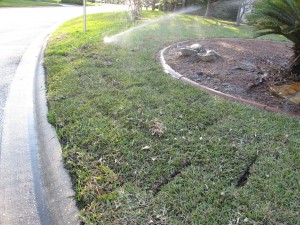Likely, summer heat and drought have taken their toll on your home lawn. Late summer and fall are opportune times to start a new home lawn. Rainfall is usually plentiful and cooler day-night temperatures should spur a rapid grass recovery.
If your home lawn is mostly weeds, including unwanted bermuda grass, think about starting over. First, you should kill off all existing vegetation without injuring nearby trees and shrubs. Herbicides containing glyphosate (Roundup™ is a popular brand) should be applied with a second follow-up application 2-3 weeks later.
You should test your soil at the local county Extension office to accurate amounts of lime and fertilizer to add. General recommendation: Apply granular fertilizer such as 10-10-10 or equivalent @ 20 -25 lbs per 1000 sq. ft. of ground. You can substitute 19-19-19 @ 10-12 lbs. per 1000 square ft. Rototill the fertilizer into the top 6 to 8 inches of soil and rake the ground smooth.
In USDA hardiness zones 4-7, cool season grasses such as tall fescue, ryegrass, and bluegrass are the preferred lawn grasses. Red or chewings fescue are best for cool shady areas. Bermuda, centipede, zoysia, or St. Augustine grasses are sprigged in late spring thru summer in warm climes (zones 7-10). See package directions for proper seeding rate in your area of the country.
Gently rake the seeds into the top quarter inch of soil and cover with 1-2 bales of straw (not hay). Keep the soil surface moist until seeds have germinated. If you have laid sod, spritz (lightly irrigate) daily until the sod has rooted into the soil, usually within 2-3 weeks.
Fertilize your lawn with a high nitrogen-based fertilizer that also contains lesser amounts of phosphorus (P) and potassium (K). The application rate is written on the bag directions. Fertilizing will not injure young seedlings or newly laid sod. Cool weather and adequate natural rainfall (or irrigation) adds to success.
Depending where you live, mid- to late- October is the deadline to seed a new lawn.


 Posted in
Posted in 
